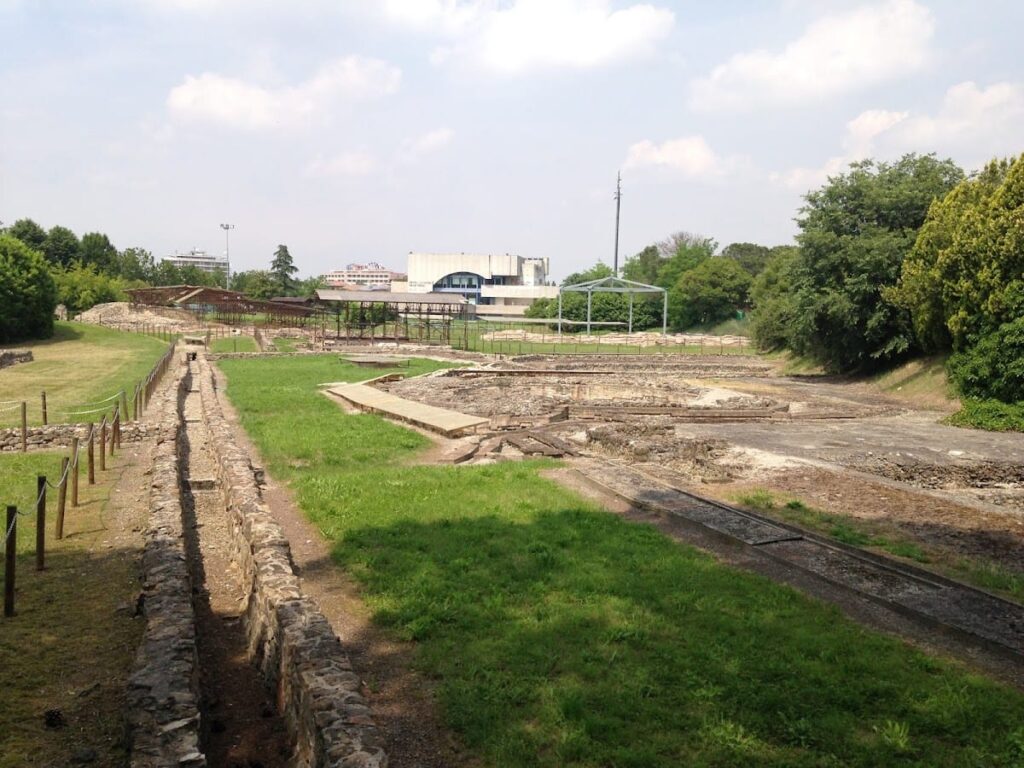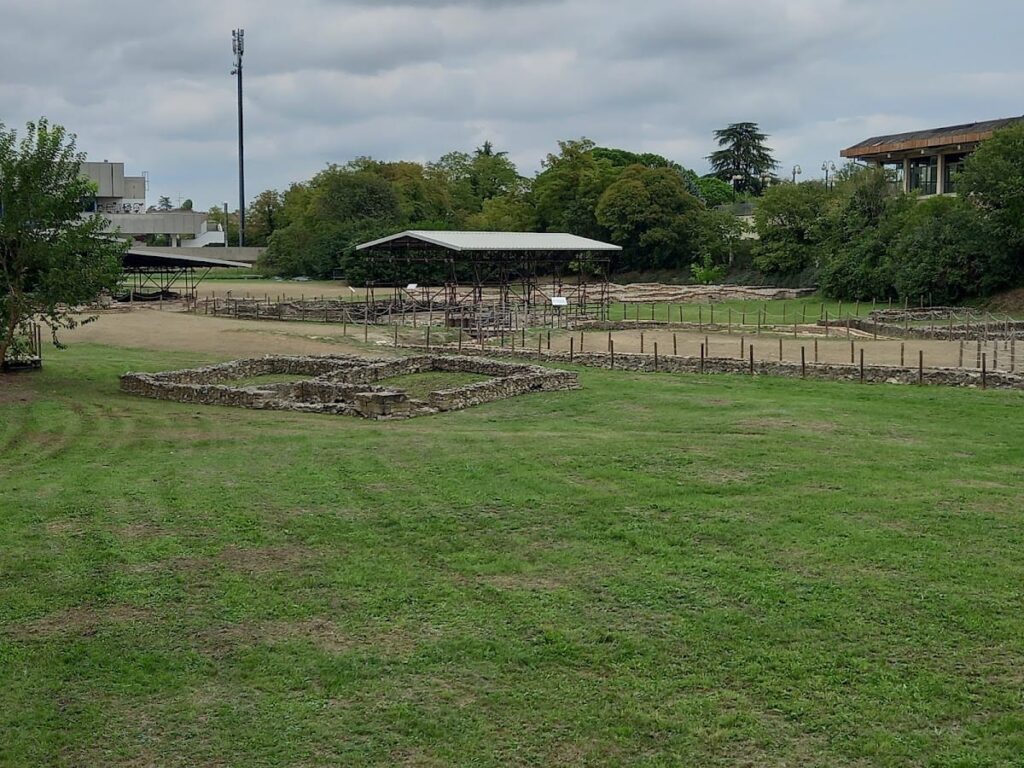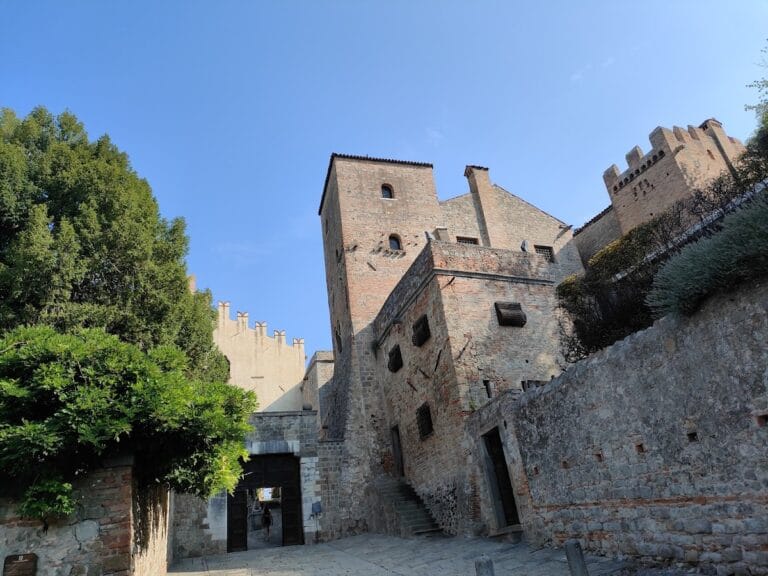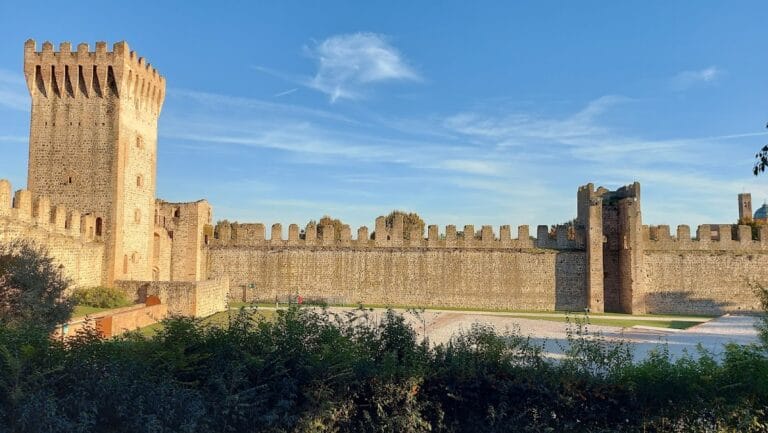Area archeologica di viale Stazione/via degli Scavi: Roman Thermal Complex in Montegrotto Terme, Italy
Table of Contents
Visitor Information
Google Rating: 3.8
Popularity: Very Low
Google Maps: View on Google Maps
Official Website: www.aquaepatavinae.it
Country: Italy
Civilization: Roman
Remains: Sanitation
Context
The Area archeologica di viale Stazione/via degli Scavi is situated in Montegrotto Terme, within the province of Padua in the Veneto region of northern Italy. Positioned at the foothills of the Euganean Hills, a volcanic massif known for its natural thermal springs, the site occupies a landscape shaped by geothermal activity. This proximity to thermal waters significantly influenced human settlement and land use, providing a natural resource that was exploited from antiquity onward. The surrounding terrain transitions into the expansive Po Valley, facilitating regional connectivity and movement across northern Italy.
Archaeological investigations have established that the site’s primary occupation dates to the Roman period, with earlier traces attributable to the late Iron Age. The Roman phase is characterized by monumental architecture associated with thermal bathing, reflecting the integration of local geothermal features into Roman leisure and health practices. After the late Roman era, evidence for continued use or redevelopment is absent, and the reasons for the site’s decline remain archaeologically undocumented. The site’s preservation varies, with some structures visible above ground and others known only through subsurface remains.
Excavations initiated in the 20th century have revealed foundational remains and material culture that contribute to understanding Roman settlement patterns in the Euganean thermal basin. Conservation efforts aim to protect exposed features while accommodating the modern urban context of Montegrotto Terme, balancing archaeological research with heritage management and public engagement.
History
The archaeological complex at viale Stazione and via degli Scavi in Montegrotto Terme exemplifies the Roman exploitation of the Euganean thermal springs, with its development spanning from the late Iron Age through the Imperial Roman period. The site’s most significant phase corresponds to the Augustan and early Imperial eras, when monumental thermal facilities and associated structures were constructed. Its decline after the late Roman period reflects broader regional transformations in northern Italy, including economic and administrative shifts that led to the abandonment of many public amenities. The site’s history is thus closely linked to the Roman incorporation of Venetia et Histria and the subsequent waning of imperial infrastructure in late antiquity.
Roman Period: Augustan and Imperial Era
Following the Roman conquest and the establishment of the province of Venetia et Histria, Montegrotto Terme became integrated into the imperial network of thermal sites. During the late 1st century BCE and early 1st century CE, under Augustus and his successors, the site underwent substantial monumentalization. Excavations have revealed a large thermal complex comprising three contiguous pools: a southern rectangular pool, a central circular pool, and a third rectangular pool with curved short sides. These pools were enclosed within a covered structure and designed for immersion bathing, with depths under one meter, reflecting Roman adaptations to local geothermal resources.
Complementing the baths, a small covered theater or odeon was constructed in the same period. The theater featured a cavea with eleven steps, accessible via a central and two lateral stairways. Spectators entered through two corridors flanking the stage, which retained a brick floor and five lead-lined pits for wooden curtain poles. The scenic backdrop included semicircular and rectangular niches, three doors connecting to the backstage area, and symmetrical side rooms serving as foyers. Foundations at the cavea’s summit indicate the presence of a tribune or small temple with adjoining rooms, suggesting a complex social and possibly religious function integrated into the entertainment space.
Another notable structure is a bi-apsed building with a quadrangular central hall flanked by two large apses on opposite sides and a circular basin at its center. Surrounding this core are rooms with small rectangular niches. Although its precise function remains uncertain, it may have been associated with individual bathing or ritual ablutions within the thermal complex.
The site’s hydraulic system demonstrates advanced Roman engineering, comprising a network of conduits extending over 200 meters and connected to a main collector. Near the theater, remains of two hydraulic wheels used to lift and distribute thermal waters have been identified, underscoring the technical sophistication employed to exploit the geothermal springs for bathing and leisure.
Discovered in the late 18th century and systematically excavated in the mid-20th century, the complex’s layout and significance have been clarified through archaeological investigation. Restoration efforts since the 1960s have focused on preserving the pools, theater, and bi-apsed building, with recent projects addressing structural conservation and provisional roofing. The site forms part of the Aquae Patavinae initiative, which aims to integrate multiple Roman thermal sites in the Euganean basin into a coordinated archaeological park.
Late Roman Period and Decline
After the Imperial peak, the site experienced a decline in use and maintenance, consistent with wider regional patterns in northern Italy during late antiquity. Economic contraction, administrative reorganization, and external pressures such as barbarian incursions contributed to the abandonment of public amenities including thermal complexes. Archaeological evidence at Montegrotto Terme shows no structural modifications or inscriptions from the late Roman or early medieval periods, indicating cessation of occupation and disuse of the baths and theater.
The decline reflects the fragmentation of Roman civic structures and the reduction of regional connectivity. Religious practices likely shifted toward Christianity in the broader Veneto region, but no direct evidence of ecclesiastical presence or ritual continuity has been found on-site. The site’s diminished role corresponds with the transformation of settlement patterns and infrastructure in late Roman Venetia.
Daily Life and Importance by Period
Roman Period: Augustan and Imperial Era
Under Roman rule, Montegrotto Terme developed into a site of regional importance centered on a monumental thermal complex that combined leisure, social, and possibly religious functions. The population comprised Roman settlers and local inhabitants acculturated to imperial customs. Social stratification is suggested by the presence of elite patrons who commissioned public amenities such as baths and a theater. Public bathing served as a social equalizer, while domestic life remained gendered according to Roman norms. Family units ranged from nuclear households to extended kin groups, with slaves and freedpersons likely employed in service and maintenance roles within the complex.
Economic activities focused on the exploitation of geothermal waters for therapeutic and recreational bathing, supported by sophisticated hydraulic engineering including conduits and mechanical wheels. Artisans and laborers specialized in construction, maintenance, and hospitality services operated at workshop or estate scales. Agriculture in the surrounding plain supplemented local needs, producing staples such as grain, olives, and wine, consumed alongside fish and fruits, consistent with regional dietary patterns. Clothing reflected typical Roman styles, including tunics, cloaks, and sandals.
While direct evidence for domestic interiors at Montegrotto is limited, public structures such as the theater and baths incorporated architectural niches, foyers, and a possible temple or tribune, indicating a blend of entertainment, ritual, and civic functions. Cultural life included performances and social gatherings within the odeon, complementing bathing rituals. Religious practices likely combined imperial cult observances with local deities associated with thermal waters, although no specific inscriptions attest to this. The site functioned as a civic and leisure center within Venetia et Histria, attracting visitors from the region and reinforcing Roman cultural integration.
Late Roman Period and Decline
Following the Imperial period, the site’s use and maintenance declined markedly, reflecting broader regional transformations in northern Italy during late antiquity. Population decline or relocation, economic contraction, and administrative changes disrupted established settlement patterns. Public amenities such as the thermal complex and theater fell into disuse.
Remains
Architectural Features
The archaeological remains at viale Stazione and via degli Scavi comprise a complex of Roman structures predominantly dating to the late 1st century BCE and early 1st century CE. The site includes a monumental thermal complex, a small covered theater or odeon, a bi-apsed building with a central hall, and an extensive hydraulic system. Construction techniques involve brickwork and masonry characteristic of the Augustan and early Imperial periods. The layout reflects a specialized function focused on thermal bathing and entertainment rather than residential or military use. Preservation ranges from well-defined foundations and walls to fragmentary and subsurface features revealed through excavation.
Key Buildings and Structures
Thermal Pools
The thermal complex contains three contiguous pools constructed in the late 1st century BCE or early 1st century CE. The southern pool has a rectangular plan, the central pool is circular, and the third pool is rectangular with curved short sides. All pools are shallow, with depths under one meter, indicating their use for immersion bathing. These pools were enclosed within a covered building, of which partial remains survive. The pools were documented as early as the 18th century, enabling reconstruction of their full extent. Thermal waters were supplied by an advanced hydraulic system connected to natural geothermal springs.
Theater (Odeon)
The small theater or odeon was erected between the late 1st century BCE and early 1st century CE. It features a cavea with eleven steps, accessible via a central staircase and two lateral stairways. Spectators entered through two side corridors flanking the stage. The stage floor (hyposcenium) is preserved with brickwork and contains five lead-lined pits used to anchor wooden curtain poles. The scenic backdrop includes semicircular and rectangular niches and three doorways leading to the backstage area (postscaenium). Symmetrical side rooms adjacent to the backdrop served as foyers. Foundations at the top of the cavea indicate a tribune or small temple with adjoining rooms. The theater underwent structural modifications after its initial construction.
Bi-Apsidal Building
This building, dating to the Augustan or early Imperial period, has a complex plan centered on a quadrangular hall flanked by two large apses on opposite sides. A circular basin occupies the central hall. On the remaining two sides, there are series of rooms, some containing small rectangular niches. The precise function of this structure remains uncertain, but it may have been related to individual bathing or ritual ablutions. The remains are visible and have been subject to restoration efforts.
Hydraulic System
The site preserves remnants of an extensive hydraulic network designed to channel thermal waters. The system includes a main collector and a network of conduits extending over 200 meters. Near the theater, two hydraulic wheels were installed to lift and distribute water throughout the complex. These wheels remain preserved in situ within their housing structures. The hydraulic infrastructure demonstrates the technical measures employed to exploit the geothermal springs for bathing and other uses.
Other Buildings
In addition to the main structures, a smaller building of modest dimensions is present within the site. Its function has not been definitively identified. The remains consist of foundation walls and partial masonry and are included in ongoing restoration projects.
Preservation and Current Status
The site’s structures were uncovered primarily between 1965 and 1970. Since then, restoration interventions have been undertaken using mid-20th-century methods and materials. Exposure to weather, winter frost, and a shallow water table have caused deterioration, necessitating ongoing conservation. Current restoration efforts focus on the theater’s stage floor, cleaning and stabilizing the thermal pools, providing provisional coverings, and repairing the bi-apsed building. Despite these challenges, the area remains accessible for study and controlled visitation. Conservation efforts seek to balance archaeological preservation with integration into the modern urban environment of Montegrotto Terme.










